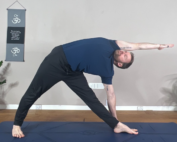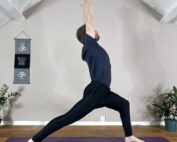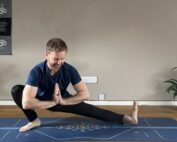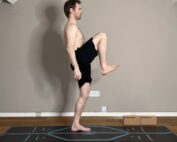
Discover the Steps and Benefits of Child’s Pose (Balasana)
Hello! I’m Dav Jones, a yoga teacher and teacher trainer, and I’m here to guide you through one of yoga’s most calming and restorative poses—Child’s Pose or Balasana. This simple yet powerful posture embodies relaxation and surrender, providing a much-needed pause in your practice and life. Whether you’re new to yoga or an experienced practitioner, Child’s Pose is your go-to for grounding and reconnecting. Let’s explore its benefits, steps, and variations together!
What is Child’s Pose (Balasana)?
A Posture of Rest and Rejuvenation
Child’s Pose is often called a resting pose in yoga, but its effects go far beyond simple relaxation. This forward-folding asana gently stretches and decompresses the body while calming the mind.
Origins of Balasana
Derived from the Sanskrit words “bala” (child) and “asana” (pose), Child’s Pose mimics the fetal position—a physical expression of comfort and surrender. This posture represents humility and a return to simplicity.
Child’s Pose Basics
- Sanskrit Name: Balasana
- Pronunciation: Bah-LAHS-uh-nah
- Pose Type: Restorative, forward fold
- Level: Beginner
- Primary Focus: Flexibility, spinal health, relaxation, and grounding
The Benefits of (Balasana)
Physical Benefits</p>
- Improves Spinal Flexibility: Stretches the spine, hips, thighs, and ankles.
- Relieves Back Tension: Decompresses the lower back, and provides increased space to the posterior body.
- Enhances Digestion: Gently massages abdominal organs, promoting healthy digestion.
- Opens Hips and Knees: Eases stiffness in the lower body while improving joint mobility.
Mental and Emotional Benefits
- Calms the Mind: Encourages mindfulness through deep breathing and stillness.
- Reduces Stress: Activates the parasympathetic nervous system, promoting relaxation.
- Restores Energy: Acts as a mini-reset, perfect for moments of overwhelm or fatigue.
Preparatory Poses to Enhance Child’s Pose
Before settling into Balasana, these preparatory poses can help loosen up your body and maximize its benefits:


Warms up the spine, improving flexibility for the forward fold.

Stretches the back and hamstrings, making it easier to fold forward.
3. Thread the Needle Pose (Parsva Balasana):

Opens the shoulders and thoracic spine.
4. Happy Baby Pose (Ananda Balasana):

Relaxes the hips and lower back, preparing the body for stillness.
Step-by-Step Guide to Child’s Pose
Step 1: Get into Position
- Kneel on your mat with your big toes touching and your knees hip-width apart.
- Sit back onto your heels.
Step 2: Fold Forward
- Lower your torso between your thighs.
- Extend your arms forward with palms down or let them rest alongside your body with palms up.
Step 3: Rest Your Forehead
- Let your forehead gently rest on the mat or a yoga block.
- Relax your shoulders, neck, and jaw.
Step 4: Breathe and Relax
- Take deep breaths into your back ribs, letting the fascial tissue between your back ribs stretch through the inhale breath.
- Depending on your needs, bringing the knees together is an alternative which can provide more flexion in the spine which in turn will increase the opening of the back ribs.
Common Mistakes to Avoid
- Neck Strain: Ensure your forehead is fully supported to avoid tension in your neck.
- Knee Discomfort: Use a blanket under your knees for added cushioning if necessary.
- Forcing the Fold: Avoid pushing your body too far—Child’s Pose is about surrender, not strain.
Modifications and Variations of Child’s Pose
Wide-Knee Child’s Pose
Separate your knees wider than your hips to create space in your lower back and hips. This variation is great for relieving tension in tight hips and promoting relaxation.
Extended Child’s Pose (Utthita Balasana)
Reach your arms forward, stretching and activating your shoulders and lengthening your side body. This is a nice way to provide more of an ‘active’ version of Child’s Pose.
Supported Child’s Pose
Use a bolster or folded blanket under your chest or hips for added comfort. Ideal for restorative yoga or those with a tight lower back or knees.
Chair-Assisted Child’s Pose
Sit on a chair, fold forward, and rest your torso on your thighs or a table. Perfect for seniors or those with limited mobility.
Twisted Child’s Pose
Thread one arm under the other, resting your head and shoulder on the mat. This gently stretches your shoulders and spine.
Incorporating Child’s Pose into Daily Life
Child’s Pose is a versatile tool for relaxation and restoration. Here’s how to make it part of your routine:
- Morning Reset: Start your day with Balasana to center your mind and body.
- Workday Break: Use it as a quick desk-friendly stretch to release tension.
- Evening Unwind: Add it to your bedtime routine to calm your mind and prepare for restful sleep.
Breathwork and Mindfulness in Child’s Pose
In Balasana, focus on your breath to deepen your relaxation.
- Inhale: Feel your breath expanding your back and sides.
- Exhale: Let go of tension, visualizing stress melting away.
This mindful breathing enhances the pose’s calming effects, making it a meditative experience.
Final Thought
We’ve explored Child’s Pose, showcasing its steps, benefits, and variations to enhance your yoga journey. If you’re looking to deepen your practice, explore Dav Jones online yoga classes on Patreon, where tailored sequences await. For a more personalized approach to your yoga path, consider the Dav Jones Yoga Mentorship Program for expert guidance and support.









